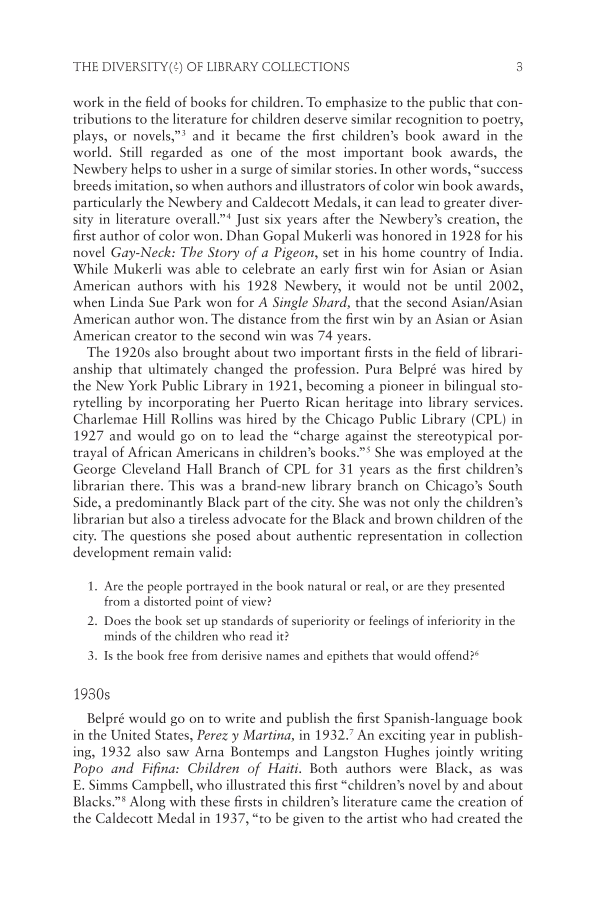The Diversity(?) of Library Collections 3 work in the field of books for children. To emphasize to the public that con- tributions to the literature for children deserve similar recognition to poetry, plays, or novels,”3 and it became the first children’s book award in the world. Still regarded as one of the most important book awards, the Newbery helps to usher in a surge of similar stories. In other words, “success breeds imitation, so when authors and illustrators of color win book awards, particularly the Newbery and Caldecott Medals, it can lead to greater diver- sity in literature overall.”4 Just six years after the Newbery’s creation, the first author of color won. Dhan Gopal Mukerli was honored in 1928 for his novel Gay-Neck: The Story of a Pigeon, set in his home country of India. While Mukerli was able to celebrate an early first win for Asian or Asian American authors with his 1928 Newbery, it would not be until 2002, when Linda Sue Park won for A Single Shard, that the second Asian/Asian American author won. The distance from the first win by an Asian or Asian American creator to the second win was 74 years. The 1920s also brought about two important firsts in the field of librari- anship that ultimately changed the profession. Pura Belpré was hired by the New York Public Library in 1921, becoming a pioneer in bilingual sto- rytelling by incorporating her Puerto Rican heritage into library services. Charlemae Hill Rollins was hired by the Chicago Public Library (CPL) in 1927 and would go on to lead the “charge against the stereotypical por- trayal of African Americans in children’s books.”5 She was employed at the George Cleveland Hall Branch of CPL for 31 years as the first children’s librarian there. This was a brand-new library branch on Chicago’s South Side, a predominantly Black part of the city. She was not only the children’s librarian but also a tireless advocate for the Black and brown children of the city. The questions she posed about authentic representation in collection development remain valid: 1. Are the people portrayed in the book natural or real, or are they presented from a distorted point of view? 2. Does the book set up standards of superiority or feelings of inferiority in the minds of the children who read it? 3. Is the book free from derisive names and epithets that would offend?6 1930s Belpré would go on to write and publish the first Spanish-language book in the United States, Perez y Martina, in 1932.7 An exciting year in publish- ing, 1932 also saw Arna Bontemps and Langston Hughes jointly writing Popo and Fifina: Children of Haiti. Both authors were Black, as was E. Simms Campbell, who illustrated this first “children’s novel by and about Blacks.”8 Along with these firsts in children’s literature came the creation of the Caldecott Medal in 1937, “to be given to the artist who had created the
Document Details My Account Print multiple pages
Print
You have printed 0 times in the last 24 hours.
Your print count will reset on at .
You may print 0 more time(s) before then.
You may print a maximum of 0 pages at a time.

































































































































































